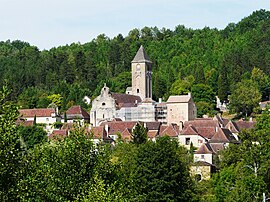Plazac
This article has multiple issues. Please help improve it or discuss these issues on the talk page. (Learn how and when to remove these messages)
|
Plazac | |
|---|---|
 A general view of Plazac | |
| Coordinates: 45°02′09″N 1°02′25″E / 45.0358°N 1.0403°E | |
| Country | France |
| Region | Nouvelle-Aquitaine |
| Department | Dordogne |
| Arrondissement | Sarlat-la-Canéda |
| Canton | Vallée de l'Homme |
| Government | |
| • Mayor (2008–2014) | Robert Delbary |
| Area 1 | 33.77 km2 (13.04 sq mi) |
| Population (2021)[1] | 703 |
| • Density | 21/km2 (54/sq mi) |
| Time zone | UTC+01:00 (CET) |
| • Summer (DST) | UTC+02:00 (CEST) |
| INSEE/Postal code | 24330 /24580 |
| Elevation | 82–289 m (269–948 ft) (avg. 100 m or 330 ft) |
| 1 French Land Register data, which excludes lakes, ponds, glaciers > 1 km2 (0.386 sq mi or 247 acres) and river estuaries. | |
Plazac is a commune in the Dordogne department in Nouvelle-Aquitaine in southwestern France. It is near the village of Les Eyzies and the city of Sarlat-la-Canéda.
There are at least 20 nationalities represented among the villagers, and there is a lively social scene. A typical dinner will last for at least five hours and draw heavily on the products from the nearby Bordeaux wine region, as well as the local game, truffles, cepes (wild mushrooms) and foie gras.
Plazac was founded by the Archbishop of Périgueux, who used it as a country retreat. Parts of the village, including the church, date back to the 12th century. It is rumored that there are tunnels beneath the village, used during conflicts over centuries. There is certainly a spring which feeds underground passages sending water to the church and its attached presbytery with the excess flowing beneath the streets to the nearby Vimont River.
Plazac is in the Périgord Noir, a region severely affected by the Hundred Years' War. As a result, the hills are studded with castles and chateaus. The nearby Dordogne River formed the border between the English and the French, who were north of the river. Along the river there are many castles in pairs, one on the north, the other on the south bank. One of the most interesting is Castelnaud (English) and Beynac, which has been completely restored to its original state and is a famous attraction in the region.
During World War II, Plazac sheltered the residents of Bindernheim who fled from the site of heavy fighting. The people of Bindernheim created a garden and fountain in Plazac as means of gratitude. In the next village, Rouffignac, the Nazis, who were searching for members of French Resistance gave the mayor a choice: they would kill all the males in the village or burn the village to the ground. Consequently, most of Rouffignac dates from the late 1940s.
In addition to castles and chateaus, the area is honeycombed with caves. The most famous is Lascaux near Montignac (15 minutes from Plazac) where the famous cave paintings were discovered. Another famous cave is Les Grottes de Rouffignac, where a battery-powered railway takes visitors over a mile underground to see cave paintings including pictures of mammoths which were drawn from life.
Population
| Year | Pop. | ±% |
|---|---|---|
| 1962 | 522 | — |
| 1968 | 424 | −18.8% |
| 1975 | 427 | +0.7% |
| 1982 | 502 | +17.6% |
| 1990 | 543 | +8.2% |
| 1999 | 578 | +6.4% |
| 2008 | 736 | +27.3% |
See also
References
- ^ "Populations légales 2021" (in French). The National Institute of Statistics and Economic Studies. 28 December 2023.




